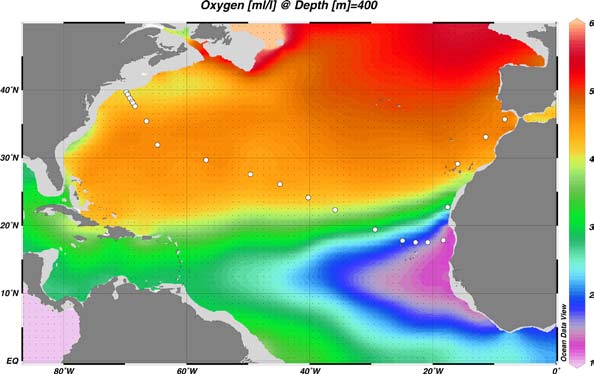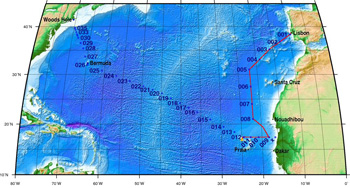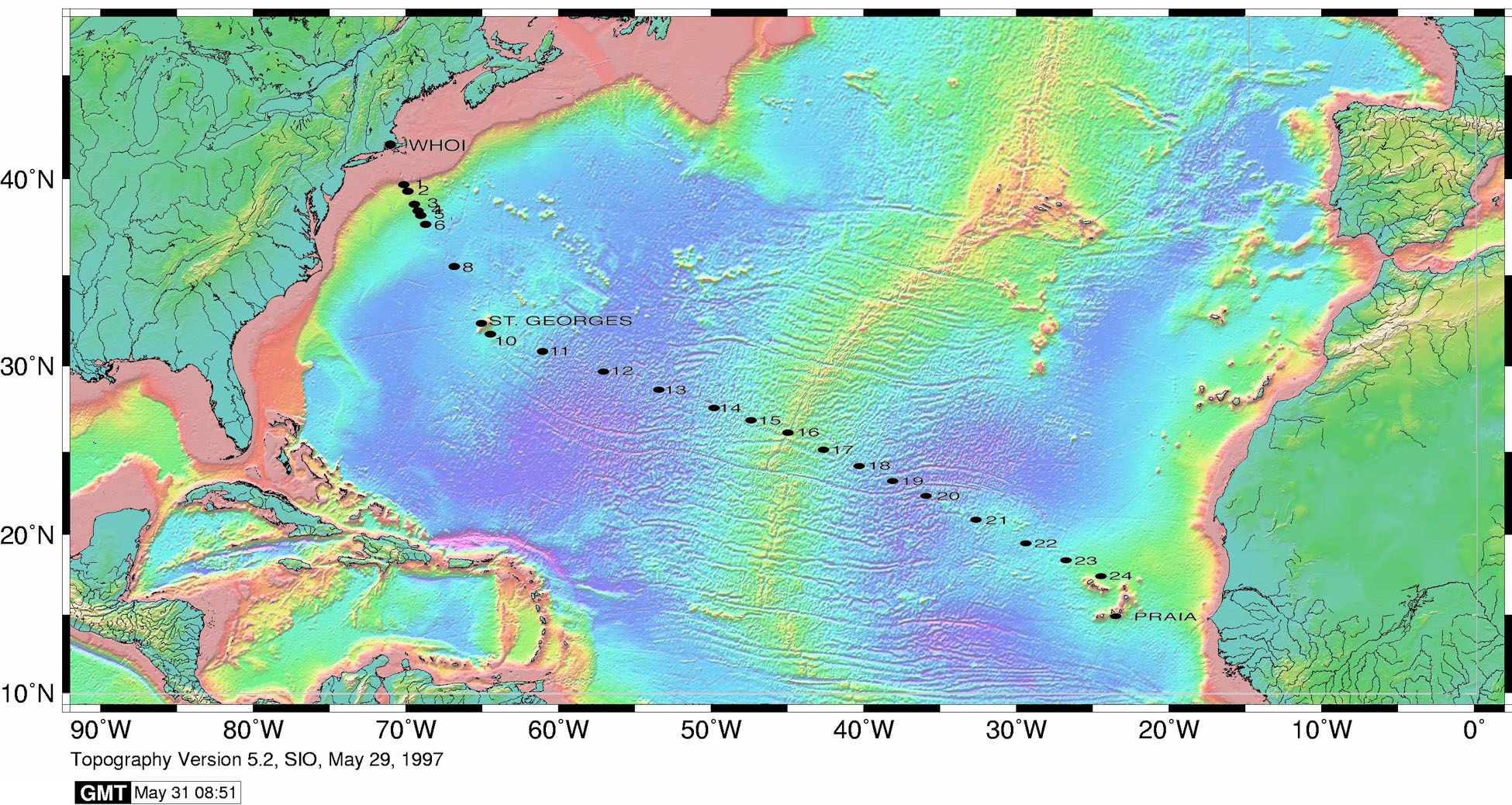Bottle sampling comments associated with the US GEOTRACES North Atlantic Transect from the R/V Knorr KN204-01 cruise in the subtropical N. Atlantic during 2011 (U.S. GEOTRACES NAT project)
Project
Program
| Contributors | Affiliation | Role |
|---|---|---|
| Boyle, Edward A. | Massachusetts Institute of Technology (MIT) | Principal Investigator, Contact |
| Gegg, Stephen R. | Woods Hole Oceanographic Institution (WHOI BCO-DMO) | BCO-DMO Data Manager |
Abstract
Bottle sampling comments for GT11/KN204-01 A/B
Refer to KN204-01 A/B Cruise Report for detailed descriptions of acquisition and processing methodologies
BCO-DMO Processing Notes
- Generated from original text file "gt11_sample_comments.txt" contributed by Ed Boyle
- Date field split into seperate date/time fields
- Cast field split into station number and cast
- Date reformatted to YYYYMMDD
- Time reformatted to HHMMSS
- Columns added for cruise_id, lat, lon and type (GT-C or SIOR)
- Dates, times, lats, lons and types inserted from cast events log using "Bot" data
- Commas in comments column converted to semicolons
| File |
|---|
CTD_SampleComments_GT11.csv (Comma Separated Values (.csv), 66.85 KB) MD5:20a42efd08bcae42798db80076f64320 Primary data file for dataset ID 3664 |
| Parameter | Description | Units |
| station_GEOTRC | GEOTRACES station number; ranges from 1 through 12 for KN199-04 and 1 through 24 for KN204-01. Stations 7 and 9 were skipped on KN204-01. Originally submitted as 'station', this parameter name has been changed to conform to BCO-DMO's GEOTRACES naming conventions. | integer |
| cast_GEOTRC | Cast identifier numbered consecutively within a station. Originally submitted as 'cast_no'; this parameter name has been changed to conform to BCO-DMO's GEOTRACES naming conventions. | integer |
| date | Event date in the format YYYYMMDD | unitless |
| time | Event time | HHMMSS |
| lat | Event Latitude (South is negative) | decimal degrees |
| lon | Event Longitude (West is negative) | decimal degrees |
| comments | Bottle sampling comment | text |
| cruise_part | Identifier for a segment of a cruise leg, where a leg may have been broken into parts | text |
| type | Rosette type (GT-C or ODF/SIOR) | text |
| sample_bottle_GEOTRC | Unique identification numbers given to samples taken from bottles; rangies from 1 to 24; often used synonymously with bottle number. Originally submitted as 'SampNo'; this parameter name has been changed to conform to BCO-DMO's GEOTRACES naming conventions. | integer |
| sample_GEOTRC | Unique identifying number for US GEOTRACES samples; ranges from 5033 to 6078 for KN199-04 and from 6112 to 8148 for KN204-01. Originally submitted as 'GeoNo', this parameter name has been changed to conform to BCO-DMO's GEOTRACES naming conventions. | integer |
| property | Property sampled | text |
| code | Property sampled code | integer |
| who | Person entering comment | text |
| ISO_DateTime_UTC | Date/Time formatted to ISO 8601 standard. T indicates start of time string; Z indicates UTC. Calculated using 'date' and 'time' parameters as input. | YYYY-mm-ddTHH:MM:SS.ssZ |
| Dataset-specific Instrument Name | CTD Sea-Bird SBE 911plus |
| Generic Instrument Name | CTD Sea-Bird SBE 911plus |
| Dataset-specific Description | CTD/Hydrographic Measurements Program
Two types of rosette/SBE9plus CTD casts (65 SIOR/30L-Niskin and 40 GT-C/15L-GoFlo) were made at 22 station locations during GEOTRACES 2011.
13 shallow and 13 deep McLane pump profiles were done at all Full and Super Stations, with an SBE19plus CTD attached to the end of the wire. |
| Generic Instrument Description | The Sea-Bird SBE 911 plus is a type of CTD instrument package for continuous measurement of conductivity, temperature and pressure. The SBE 911 plus includes the SBE 9plus Underwater Unit and the SBE 11plus Deck Unit (for real-time readout using conductive wire) for deployment from a vessel. The combination of the SBE 9 plus and SBE 11 plus is called a SBE 911 plus. The SBE 9 plus uses Sea-Bird's standard modular temperature and conductivity sensors (SBE 3 plus and SBE 4). The SBE 9 plus CTD can be configured with up to eight auxiliary sensors to measure other parameters including dissolved oxygen, pH, turbidity, fluorescence, light (PAR), light transmission, etc.). more information from Sea-Bird Electronics |
| Dataset-specific Instrument Name | GO-FLO Bottle |
| Generic Instrument Name | GO-FLO Bottle |
| Dataset-specific Description | CTD/Hydrographic Measurements Program
Two types of rosette/SBE9plus CTD casts (65 SIOR/30L-Niskin and 40 GT-C/15L-GoFlo) were made at 22 station locations during GEOTRACES 2011.
13 shallow and 13 deep McLane pump profiles were done at all Full and Super Stations, with an SBE19plus CTD attached to the end of the wire. |
| Generic Instrument Description | GO-FLO bottle cast used to collect water samples for pigment, nutrient, plankton, etc. The GO-FLO sampling bottle is specially designed to avoid sample contamination at the surface, internal spring contamination, loss of sample on deck (internal seals), and exchange of water from different depths. |
| Dataset-specific Instrument Name | Niskin bottle |
| Generic Instrument Name | Niskin bottle |
| Dataset-specific Description | CTD/Hydrographic Measurements Program
Two types of rosette/SBE9plus CTD casts (65 SIOR/30L-Niskin and 40 GT-C/15L-GoFlo) were made at 22 station locations during GEOTRACES 2011.
13 shallow and 13 deep McLane pump profiles were done at all Full and Super Stations, with an SBE19plus CTD attached to the end of the wire. |
| Generic Instrument Description | A Niskin bottle (a next generation water sampler based on the Nansen bottle) is a cylindrical, non-metallic water collection device with stoppers at both ends. The bottles can be attached individually on a hydrowire or deployed in 12, 24, or 36 bottle Rosette systems mounted on a frame and combined with a CTD. Niskin bottles are used to collect discrete water samples for a range of measurements including pigments, nutrients, plankton, etc. |
KN204-01
| Website | |
| Platform | R/V Knorr |
| Report | |
| Start Date | 2011-11-06 |
| End Date | 2011-12-11 |
| Description | The US GEOTRACES North Atlantic cruise aboard the R/V Knorr completed the section between Lisbon and Woods Hole that began in October 2010 but was rescheduled for November-December 2011. The R/V Knorr made a brief stop in Bermuda to exchange samples and personnel before continuing across the basin. Scientists disembarked in Praia, Cape Verde, on 11 December. The cruise was identified as KN204-01A (first part before Bermuda) and KN204-01B (after the Bermuda stop). However, the official deployment name for this cruise is KN204-01 and includes both part A and B.
Science activities included: ODF 30 liter rosette CTD casts, ODU Trace metal rosette CTD casts, McLane particulate pump casts, underway sampling with towed fish and sampling from the shipboard "uncontaminated" flow-through system.
Full depth stations are shown in the accompanying figure (see below). Additional stations to sample for selected trace metals to a depth of 1000 m are not shown. Standard stations are shown in red (as are the ports) and "super" stations, with extra casts to provide large-volume samples for selected parameters, are shown in green.
Station spacing is concentrated along the western margin to evaluate the transport of trace elements and isotopes by western boundary currents. Stations across the gyre will allow scientists to examine trace element supply by Saharan dust, while also contrasting trace element and isotope distributions in the oligotrophic gyre with conditions near biologically productive ocean margins, both in the west, to be sampled now, and within the eastern boundary upwelling system off Mauritania, sampled last year.
Funding: The cruise was funded by NSF OCE awards 0926204, 0926433 and 0926659.
Additional cruise information is available from the Rolling Deck to Repository (R2R): https://www.rvdata.us/search/cruise/KN204-01
Other Relevant Links:
ADCP data are available from the Currents ADCP group at the University of Hawaii at the links below:
KN204-01A (part 1 of 2011 cruise; Woods Hole, MA to Bermuda)
KN204-01B (part 2 of 2011 cruise; Bermuda to Cape Verde) Methods & Sampling Refer to KN204-01 A/B Cruise Report for detailed descriptions of acquisition and processing methodologies Processing Description |
U.S. GEOTRACES North Atlantic Transect (GA03) (U.S. GEOTRACES NAT)
Much of this text appeared in an article published in OCB News, October 2008, by the OCB Project Office.
The first U.S. GEOTRACES Atlantic Section will be specifically centered around a sampling cruise to be carried out in the North Atlantic in 2010. Ed Boyle (MIT) and Bill Jenkins (WHOI) organized a three-day planning workshop that was held September 22-24, 2008 at the Woods Hole Oceanographic Institution. The main goal of the workshop, sponsored by the National Science Foundation and the U.S. GEOTRACES Scientific Steering Committee, was to design the implementation plan for the first U.S. GEOTRACES Atlantic Section. The primary cruise design motivation was to improve knowledge of the sources, sinks and internal cycling of Trace Elements and their Isotopes (TEIs) by studying their distributions along a section in the North Atlantic (Figure 1). The North Atlantic has the full suite of processes that affect TEIs, including strong meridional advection, boundary scavenging and source effects, aeolian deposition, and the salty Mediterranean Outflow. The North Atlantic is particularly important as it lies at the "origin" of the global Meridional Overturning Circulation.
It is well understood that many trace metals play important roles in biogeochemical processes and the carbon cycle, yet very little is known about their large-scale distributions and the regional scale processes that affect them. Recent advances in sampling and analytical techniques, along with advances in our understanding of their roles in enzymatic and catalytic processes in the open ocean provide a natural opportunity to make substantial advances in our understanding of these important elements. Moreover, we are motivated by the prospect of global change and the need to understand the present and future workings of the ocean's biogeochemistry. The GEOTRACES strategy is to measure a broad suite of TEIs to constrain the critical biogeochemical processes that influence their distributions. In addition to these "exotic" substances, more traditional properties, including macronutrients (at micromolar and nanomolar levels), CTD, bio-optical parameters, and carbon system characteristics will be measured. The cruise starts at Line W, a repeat hydrographic section southeast of Cape Cod, extends to Bermuda and subsequently through the North Atlantic oligotrophic subtropical gyre, then transects into the African coast in the northern limb of the coastal upwelling region. From there, the cruise goes northward into the Mediterranean outflow. The station locations shown on the map are for the "fulldepth TEI" stations, and constitute approximately half of the stations to be ultimately occupied.
Figure 1. The proposed 2010 Atlantic GEOTRACES cruise track plotted on dissolved oxygen at 400 m depth. Data from the World Ocean Atlas (Levitus et al., 2005) were plotted using Ocean Data View (courtesy Reiner Schlitzer). [click on the image to view a larger version]

Hydrography, CTD and nutrient measurements will be supported by the Ocean Data Facility (J. Swift) at Scripps Institution of Oceanography and funded through NSF Facilities. They will be providing an additional CTD rosette system along with nephelometer and LADCP. A trace metal clean Go-Flo Rosette and winch will be provided by the group at Old Dominion University (G. Cutter) along with a towed underway pumping system.
The North Atlantic Transect cruise began in 2010 with KN199 leg 4 (station sampling) and leg 5 (underway sampling only) (Figure 2).
Figure 2. The red line shows the cruise track for the first leg of the US Geotraces North Atlantic Transect on the R/V Knorr in October 2010. The rest of the stations (beginning with 13) will be completed in October-December 2011 on the R/V Knorr (courtesy of Bill Jenkins, Chief Scientist, GNAT first leg). [click on the image to view a larger version]

The section completion effort resumed again in November 2011 with KN204-01A,B (Figure 3).
KN204-01A,B Cruise Report (PDF)
Figure 3. Station locations occupied on the US Geotraces North Atlantic Transect on the R/V Knorr in November 2011. [click on the image to view a larger version]

Data from the North Atlantic Transect cruises are available under the Datasets heading below, and consensus values for the SAFe and North Atlantic GEOTRACES Reference Seawater Samples are available from the GEOTRACES Program Office: Standards and Reference Materials
ADCP data are available from the Currents ADCP group at the University of Hawaii at the links below:
KN199-04 (leg 1 of 2010 cruise; Lisbon to Cape Verde)
KN199-05 (leg 2 of 2010 cruise; Cape Verde to Charleston, NC)
KN204-01A (part 1 of 2011 cruise; Woods Hole, MA to Bermuda)
KN204-01B (part 2 of 2011 cruise; Bermuda to Cape Verde)
U.S. GEOTRACES (U.S. GEOTRACES)
GEOTRACES is a SCOR sponsored program; and funding for program infrastructure development is provided by the U.S. National Science Foundation.
GEOTRACES gained momentum following a special symposium, S02: Biogeochemical cycling of trace elements and isotopes in the ocean and applications to constrain contemporary marine processes (GEOSECS II), at a 2003 Goldschmidt meeting convened in Japan. The GEOSECS II acronym referred to the Geochemical Ocean Section Studies To determine full water column distributions of selected trace elements and isotopes, including their concentration, chemical speciation, and physical form, along a sufficient number of sections in each ocean basin to establish the principal relationships between these distributions and with more traditional hydrographic parameters;
* To evaluate the sources, sinks, and internal cycling of these species and thereby characterize more completely the physical, chemical and biological processes regulating their distributions, and the sensitivity of these processes to global change; and
* To understand the processes that control the concentrations of geochemical species used for proxies of the past environment, both in the water column and in the substrates that reflect the water column.
GEOTRACES will be global in scope, consisting of ocean sections complemented by regional process studies. Sections and process studies will combine fieldwork, laboratory experiments and modelling. Beyond realizing the scientific objectives identified above, a natural outcome of this work will be to build a community of marine scientists who understand the processes regulating trace element cycles sufficiently well to exploit this knowledge reliably in future interdisciplinary studies.
Expand "Projects" below for information about and data resulting from individual US GEOTRACES research projects.
| Funding Source | Award |
|---|---|
| NSF Division of Ocean Sciences (NSF OCE) | |
| NSF Division of Ocean Sciences (NSF OCE) |
[ table of contents | back to top ]